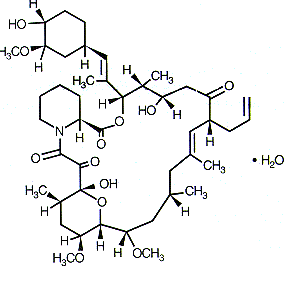Tacrolimus
Tacrolimus (also FK-506 or Fujimycin) is a 23-membered macrolide lactone discovered in 1984 from the fermentation broth of a Japanese soil sample that contained the fungus Streptomyces tsukubaensis. It is an immunosuppressive drug whose main use is after allogenic organ transplant to reduce the activity of the patient's immune system and so the risk of organ rejection. more...
It has similar immunosuppressive properties to cyclosporine, but is much more potent in equal volumes. Also like cyclosporine it has a wide range of adverse interactions, including that with grapefruit which increases plasma-tacrolimus concentration.
It has been used in a topical preparation in the treatment of severe atopic dermatitis, as have cyclosporine and azathioprine with much less success. It has also been used after bone marrow transplants and for severe refractory uveitis.
The drug is owned by Astellas Pharma Inc. (Merging of Fujisawa Pharmaceutical Co.,Ltd. and Yamanouchi Pharmaceutical Co., Ltd as of April 1, 2005) and is sold under the tradename Prograf®. It is sometimes referred to as FK-506, an early name relating to its action. It was first approved by the FDA in 1994 for use in liver transplantation, this has been extended to include kidney, heart, small bowel, pancreas, lung, trachea, skin, cornea, and limb transplants.
Tacrolimus is a macrolide antibiotic. It acts by reducing peptidyl-prolyl isomerase activity by binding to the immunophilin FKBP-12 (FK506 binding protein) creating a new complex. This inhibits both T-lymphocyte signal transduction and IL-2 transcription. Although this activity is similar to cyclosporine studies have shown that the incidence of acute rejection is reduced by tacrolimus use over cyclosporine.
Side effects can be severe and include blurred vision, liver and kidney problems (it is nephrotoxic), seizures, tremors, hypertension, hypomagnesemia, diabetes mellitus, hyperkalemia, itching, insomnia, confusion, loss of appetite, hyperglycemia, weakness, depression, cramps, and neuropathy, as well as potentially increasing the severity of existing fungal or infectious conditions such as herpes zoster or polyoma viral infections.
Dermatological use
Protopic® or tacrolimus is a recent topical treatment of eczema, particularly atopic eczema. It suppresses inflammation in a similar way to steroids, but is not as powerful. An important dermatological advantage of tacrolimus is that it can be used directly on the face; topical steroids cannot be used on the face, as they thin the skin dramatically there. On other parts of the body, topical steroid are generally a better treatment. A common side effect of tacrolimus ointment, if used over a wide area, is to cause a burning or itching sensation on the first one or two applications.
Cancer risks
Tacrolimus and a related drug for eczema (pimecrolimus) are being suspected of carrying a cancer risk, though the matter is still a subject of controversy. Dermatologists agree that the drug should be used as a second-line remedy only after conventional methods of treatment have failed. The FDA issued a health warning in March 2005 for the drug, based on animal models and a small number of patients. Until further human studies yield more conclusive results, the FDA recommends that users be advised of the potential risks.
Read more at Wikipedia.org



